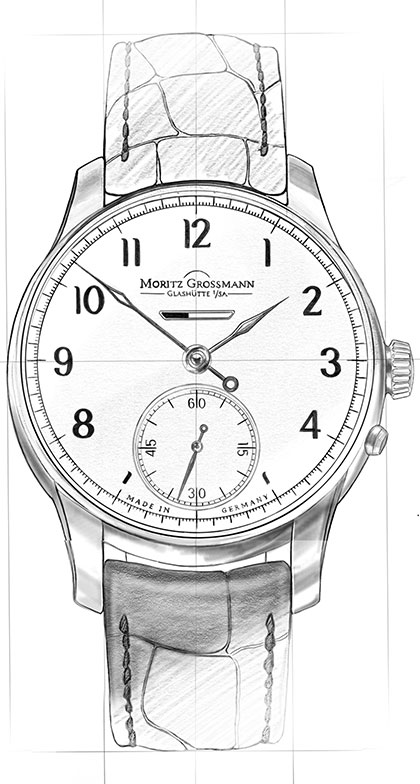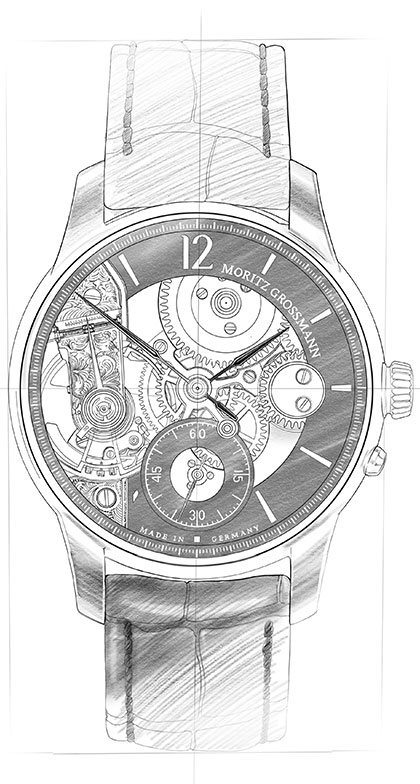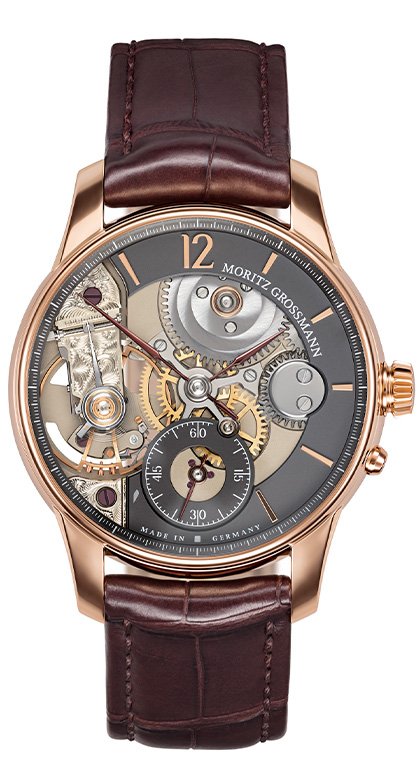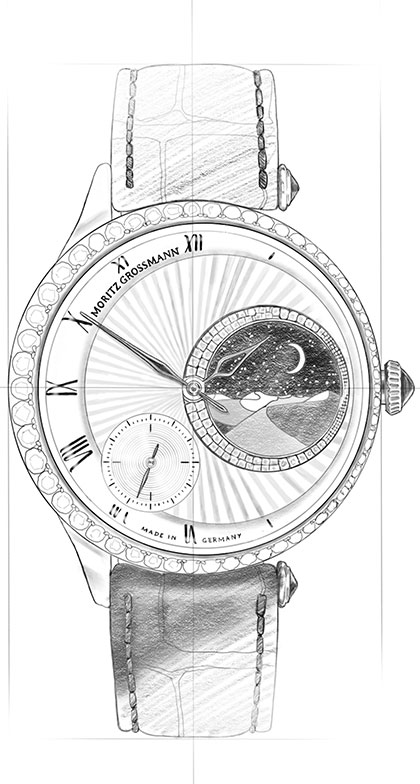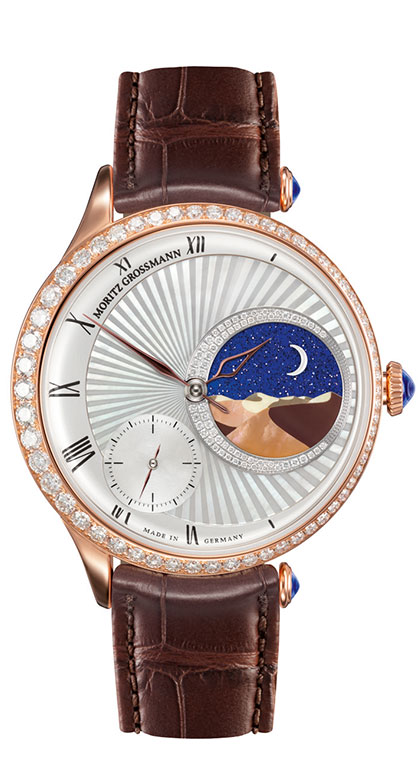The movement
Persistent renewal and improvement are part of the Grossmann heritage. Thus, the suite of proprietary developments of the up-and-coming Grossmann manufacture continues. The calibre 100.2 movement of the BENU Power Reserve is the familiar classic pillar movement with a 2/3 plate, cantilevered balance cock, and the typical Grossmann micrometer screw with which the original BENU was endowed. It incorporates all the characteristic hallmarks and artisanal details for which movements signed MORITZ GROSSMANN GLASHÜTTE I/SA are admired. Additional enhancements include the new Grossmann balance, the remodified Glashütte stopwork, the winder with pusher, and the power-reserve indicator.
The power reserve indicator
The power-reserve indicator of the BENU was inspired by a solution implemented in early Glashütte observation watches. A slender crown-wheel differential train is inserted beneath the ratchet wheel. The rotary motion that occurs when the movement is wound or the mainspring unwinds is transferred to a carrier arbor with a planetary wheel. A two-colour toothed segment displays the power reserve; it appears as a white-red bar in an elongated dial cutout. When the mainspring is fully wound, the bar is white. The red portion gradually appears as the spring winds down.
The Grossmann balance
The BENU Power Reserve breathes at a calming traditional rate of 18,000 semi-oscillations per hour. The calibre 100.2 premieres the newly designed Grossmann balance and demonstrates that rate accuracy is not achieved solely with a higher frequency. Optimised for artisanal manufacturing techniques, the design of the balance improves the adjustability of inertia and achieves high kinetic energy combined with minimised air resistance and the smallest possible mass. The number of screws in the balance-wheel rim was minimised as well. Mass screws with different head lengths are used to incrementally vary the moment of inertia. Additionally, the rim is provided with uniformly spaced bores that allow reductions in mass or contribute to the poising of the balance. The smooth cylindrical balance staff is integrated in the hub and can easily be replaced if necessary. The Grossmann balance interacts with a Nivarox balance spring which is overcoiled with a quarter arc on the inside and secured to the slotted roller with a brass pin.
The Grossmann winder with pusher
On average, a manually wound watch is reset weekly. It was a challenge for the watchmakers at Grossmann to improve the functional reliability and convenience of this operation. When the user briefly pulls the winding crown out, this mechanism switches to the handsetting mode and stops the movement. The crown immediately returns to its home position but can be turned to precisely set the hands. Afterwards, the movement is restarted with the pusher adjacent to the winding crown without altering the positions of the hands. At the same time, the mechanism switches back to the winding mode. This ingenious handsetting mechanism eliminates two possible error sources: the ingress of particles into the case while the hands are being set and the unintentional alteration of the hand positions while the crown is being pushed home again.
The index adjuster
The BENU Power Reserve features an index adjuster that allows the watch to be regulated very precisely without disturbing the equilibrium of the oscillation system. The Grossmann micrometer screw enables accurate, tension-free adjustments of the index tail in both directions.
The three-band snailing
The winding wheels have polished bevel faces in the toothing and sparkle with exceptional brilliance. The largest one, the ratchet wheel, is also decorated with traditional three-band snailing, accentuating a harmonious match with the wide ribbing and the freehand engravings.
The golden chatons
The white sapphire bearing jewels are set in prominent gold chatons. Together with their annealed pan-head screws, they stand out over the datum level of the plate. This raised arrangement, inspired by historic Grossmann pocket watches, makes it possible to remove and clean the bearing jewels individually without risking damage to the plate when resetting them.
The engravings by hand
All engravings and inscriptons on the 2/3 plate and the balance cock are always engraved by hand.
Tech Specs
Movement
Manufacture calibre 100.2, manually wound, adjusted in five positions
Special features
Grossmann balance; lateral pusher for disabling the handsetting mode and starting the movement; bar-shaped power-reserve indicator with two-coloured display segment driven by a planetary gearing system; space saving and modified Glashütte stopwork with backlash; adjustment with Grossmann micrometer screw on a cantilevered balance cock; Pillar movement with 2/3 plate and frame pillars in untreated German silver, 2/3 plate, balance cock and escape-wheel cock hand-engraved; broad horizontal Glashütte ribbing, 3-band snailing on the ratchet wheel, raised gold chatons with pan-head screws; separately removable clutch winder; stop seconds for handsetting
Functions
Hours and minutes, subsidiary seconds with stop seconds, Grossmann winder with pusher, power-reserve indicator
No. of parts
227
No. of jewels
26 jewels, 3 of which in screwed gold chatons
Escapement
Lever escapement
Oscillator
Shock-absorbed Grossmann balance with 4 inertia and 2 poising screws, Nivarox 1 balance spring with No. 80 Breguet terminal curve, Gerstenberger geometry
Balance
Diameter 14.2 mm, frequency 18,000 semi-oscillations per hour
Power reserve
42 hours when fully wound
Operating elements
Crown in 750/000 gold to wind the watch and set the time, pusher in 750/000 gold to start the movement
Movement dimensions
Diameter: 36.4 mm, height: 5.4 mm

